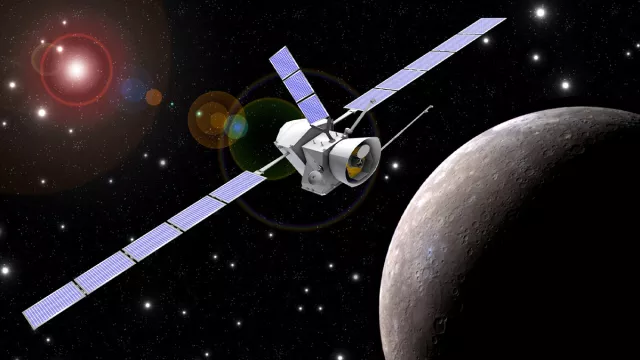In 2018, the European Space Agency (ESA) and the Japan Aerospace eXploration Agency (JAXA) launched two probes to Mercury on the BepiColombo mission to unlock the secrets of this mysterious world about which planetologists still have much to learn.
Key information
| Mission | Study of Mercury’s surface and inner structure (MPO) Study of Mercury’s magnetosphere and magnetic field (Mio) |
|---|---|
| Domain | Science |
| Launch date | 19 October 2018 |
| Partners | ESA, JAXA, IAS, IPGP, IRAP, LAM, LATMOS, LESIA, LPC2E, LPP |
| Where | Mercury orbit: 400-1,500 km (MPO) and 400-12,000 km (Mio)) |
| Nominal science mission | 1 year |
| Status | In operation |
Key figures
- 2 probes
- 16 instruments on 2 probes
- 8 French research laboratories involved
- 400-km closest approach to Mercury
Key milestones
- March 2027: Operations debut of the two probes MPO and Mio on their mercurian orbit
- November 2026: 2 probes inserted into Mercury orbit using MPO’s thrusters
- September 2026: Separation of Mercury Transfer Module (MTM)
- 8 January 2025: 6th Mercury gravity assist
- 1 December 2024: 5th Mercury gravity assist
- 5 September 2024: 4th Mercury gravity assist
- 19 June 2023: 3rd Mercury gravity assist (236 km)
- 23 June 2022: 2nd Mercury gravity assist (200 km)
- 1 October 2021: 1st Mercury gravity assist (199 km)
- 11 August 2021: Venus gravity assist
- 15 October 2020: Venus gravity assist
- 10 April 2020: Earth gravity assist
- 19 October 2018: Launch of BepiColombo by Ariane 5 ECA
Project in brief
Mercury is the least well-known of the planets in our solar system. This is largely because its proximity to the Sun makes sending space probes there challenging. To learn more about Mercury, the European BepiColombo mission launched two probes in October 2018—MPO (Mercury Planetary Orbiter) and a Mercury Magnetospheric Orbiter, renamed Mio by JAXA—to reach orbit late in 2026. MPO will map the entire surface of the planet and study its inner composition and structure, while Mio will analyse its magnetic field and magnetosphere (the layer of a planet’s atmosphere where physical characteristics are governed by the magnetic field). Data gathered will provide new insights into the formation and evolution of ‘inner’ planets—planets orbiting close to their star—like our Earth.
The MPO probe was developed by ESA and the Mio probe by JAXA.
CNES’s role
CNES oversaw development of the French instruments on BepiColombo for all of the research laboratories involved in the mission—eight in all (IAS, IPGP, IRAP, LAM, LATMOS, LESIA, LPC2E and LPP), who helped to design six of the 16 instruments.
CNES contacts
Project Leader for French contributions to BepiColombo
Anne Jean-Antoine Piccolo
E-mail: anne.jean-antoine-piccolo at cnes.fr
Planets and Small Solar System Bodies subject matter expert
Francis Rocard
E-mail: francis.rocard at cnes.fr
Sun, Heliosphere and Magnetospheres (SHM) subject matter expert
Kader Amsif
E-mail: kader.amsif at cnes.fr


